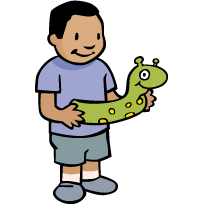Boston Children's Museum
308 Congress Street, Boston, MA 02210
617-426-6500
© Boston Children’s Museum 2025
Website Design by JackrabbitFocusing on characteristics of living things (food, shelter/protection, methods of gathering food, etc), this activity gives kids a chance to construct a 3-D model of the living things that they invented in the “Design a Critter” activity. Students will have an opportunity to practice observation and problem solving skills as well as tool use and materials manipulation. And, they get to be creative!
This activity is a follow-up to the Design a Critter activity. Make sure you have completed that activity before trying this one.
Gather all materials. Make sure you have storage space available—this may take more than one session.

Ask your students to think about the creatures they designed in the Design a Critter activity. Do they remember all of the different characteristics about their animals? Hopefully they wrote it all down and can refer to their notes. Remind them that they will now get a chance to build a model of their new living thing out of recycled material.
You’ve invented your own new critter that could live near your afterschool—now build it!
After 10-15 minutes, when each team has begun construction, gather them all together to talk about what they have done so far. Is there anything challenging about building their creature? Did any of the materials give them ideas about how to build their critter? Encourage teams to ask questions of each other.
Send teams back to their creations. When they are done and all the pain has dried, have each team present their critter to the rest of the class. Encourage the other children to ask questions about the characteristics and behavior of this new animal.